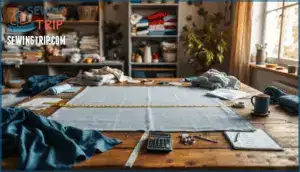This site is supported by our readers. We may earn a commission, at no cost to you, if you purchase through links.

Understanding shrinkage patterns before you cut your first piece saves you from heartbreak and wasted materials. Pre-washing fabric, adjusting your machine settings, and choosing the right seam techniques create garments that stay true to size through countless wears and washes.
Table Of Contents
- Key Takeaways
- Causes of Fabric Shrinkage in Sewing
- Essential Fabric Preparation Before Sewing
- Selecting Fabrics and Notions to Prevent Shrinkage
- Sewing Machine Settings for Shrinkage Prevention
- Seam Construction Techniques to Minimize Distortion
- Best Laundry Practices for Finished Garments
- Pro Tips for Long-Lasting, Shrink-Free Sewing
- Frequently Asked Questions (FAQs)
- Conclusion
Key Takeaways
- Pre-wash every fabric, interfacing, and trim before cutting to release manufacturing tension and prevent 3-20% shrinkage surprises after you’ve sewn your garment.
- Natural fibers like cotton and rayon shrink dramatically (up to 20%), while synthetic blends stay stable—choose your fabric knowing this behavior and test a measured sample square to calculate exact shrinkage rates.
- Your sewing machine settings matter as much as fabric prep: use a walking foot for even feeding, adjust tension to prevent puckering, and let the machine guide fabric naturally instead of pulling or pushing it through.
- Cold water washing and air drying protect finished garments far better than hot water and machine heat, which trigger fiber contraction and undo all your careful prevention work.
Causes of Fabric Shrinkage in Sewing
Understanding why fabric shrinks starts with knowing what’s happening at the fiber level. Several factors work together to change your fabric’s size after you’ve sewn it.
Let’s look at the main culprits behind fabric shrinkage so you can tackle them head-on.
Fiber Types and Their Shrinkage Tendencies
Your fabric choice sets the stage for shrinkage success. Natural fibers like cotton absorb moisture like a sponge—up to 13% water absorption—making them shrink between 4% and 10% depending on fabric density and yarn composition. Wool and linen sit comfortably at 3–4%, while silk can surprise you at over 5%.
Synthetic fibers, especially polyester and synthetic blends, barely budge (under 1%), keeping preshrunk stability. Rayon? That’s the wild card—shrinkage percentage can hit 10–20%, demanding extra prep in textile science.
Understanding cotton polyester blends is essential for minimizing shrinkage in garments.
Fabric Weave and Structure Effects
Beyond fiber content, how your fabric is woven—tight or loose, plain or textured—plays a major role in how much it’ll shrink when you sew and wash it. Tightly woven fabrics with high thread count trap more internal stress from the weaving process, leading to greater fabric distortion when exposed to moisture.
Here’s what affects fabric shrinkage in fabric structure:
- Fabric Density: Dense weaves shrink more as fibers relax
- Weave Patterns: Plain weaves stabilize better than loose basket weaves
- Thread Count: Higher counts mean tighter fiber alignment and more potential shrinkage
- Yarn Texture: Loosely spun yarns compact more than tightly twisted ones
- Fabric Properties: Knits shrink markedly more than wovens due to loop structure
You can’t change these fabric properties, but understanding them helps you choose smarter.
Heat, Moisture, and Mechanical Action
When you wash a freshly sewn garment, three forces team up to actually change its dimensions—heat, moisture, and the tumbling action of your washer or dryer. Heat exposure relaxes fibers, letting them contract. Moisture effects cause fibers to swell, then shrink as they dry. Mechanical stress from agitation tangles and tightens yarns further.
That’s why preshrinking fabric before you sew is your best defense against fabric shrinkage later.
Manufacturing Stress and Relaxation Shrinkage
Here’s the thing—long before your fabric ever touches water, it’s already under tension. Manufacturing processes like yarn spinning, weaving, and dyeing stretch fibers tight. Once you wet that fabric for the first time, those built-in stresses release, causing relaxation shrinkage—often 3–5% in knits and cotton blends.
Fabric holds manufacturing tension from spinning, weaving, and dyeing—wetting it releases that stress, causing 3–5% relaxation shrinkage in knits and cotton
Textile science calls this differential shrinkage, and it’s why fabric shrinkage prevention starts with understanding shrinkage rates and shrinkage percentage. Preshrinking lets fabric tension ease out before you cut your pattern, protecting your finished garment. Understanding fabric shrinkage types is essential for effective prevention strategies.
Essential Fabric Preparation Before Sewing
The way you treat fabric before sewing can make or break your final garment. Pre-treatment isn’t just about washing—it’s about understanding how your material behaves and planning accordingly.
Let’s walk through the key steps that’ll save you from post-project heartbreak.
Pre-washing and Drying Methods
Pre-washing your fabric isn’t just a good idea—it’s your insurance policy against a perfectly sewn garment turning into doll clothes after the first wash.
Run your fabric through the washing machine on a gentle cycle with cold water and mild detergent, then dry it exactly how you’ll treat the finished garment. This process releases manufacturing stress and removes fabric finishes that might cause unexpected shrinkage later.
Measuring and Calculating Shrinkage Rate
Before you cut a single pattern piece, grab a measuring tape and turn your pre-washed fabric into a data point—because knowing your fabric’s exact shrinkage rate is the difference between a garment that fits perfectly and one that mysteriously shrinks in the closet.
Here’s your testing method:
- Cut a 10-inch square sample size before preshrinking fabric
- Mark precise measurements on all four edges with tailor’s chalk
- Wash and dry using your garment’s care routine
- Measure again and calculate shrinkage using this formula: (original – final) ÷ original × 100
- Document rate variability for future projects—cotton shrinks 3-5%, while synthetics stay stable
This fabric measurement accounts for residual chemicals and weave relaxation.
Handling Special Fabrics (Wool, Linen, Synthetics)
Wool finishing requires cold water and flat drying—untreated knits can shrink 30%, while treated wool resists felting. Linen care means air drying after cold washes to preserve cellulose structure. Synthetic blends below 50% wool show minimal fabric relaxation thanks to heat-setting during manufacturing.
Preshrinking wool fabric, preshrinking linen fabric, and understanding synthetic fibers versus natural fibers through textile science prevents disaster. Test each material separately before preshrinking fabric for your project.
Selecting Fabrics and Notions to Prevent Shrinkage
Your fabric and notion choices can make or break your shrinkage prevention strategy. Beyond the fabric itself, you need to think about all the supporting materials—interfacing, trims, and threads—that interact with your main cloth.
Let’s walk through the key selection criteria that’ll keep your projects stable from start to finish.
Choosing Stable Fabrics for Projects
When you’re investing hours into a project, the last thing you want is fabric that fights you every step of the way—choosing stable, low-shrinkage materials from the start saves you from heartbreak later.
Look for tightly woven fabrics with balanced fiber blends—synthetic blends usually resist fabric shrinking better than 100% natural fibers like cotton or linen.
Check fabric properties by gently tugging the weave; if it distorts easily, expect movement during washing. Quality fabric selection means fewer surprises down the road.
Pre-shrinking Interfacing, Ribbons, and Trims
Your main fabric isn’t the only thing that’ll shrink in the wash—interfacing, ribbons, and trims can tighten up too, warping seams and creating unwanted ripples if you skip this vital prep step. Preshrinking interfacing alongside your fabric prep guarantees everything behaves the same way.
Toss ribbons and laces into mesh bags for a gentle wash cycle, then air dry or use low heat. This simple notion management step keeps your fabric finishing smooth and professional-looking.
Assessing Fabric Quality and Brand Labels
Not all fabric labels tell the full story—studies show that 41% of garment tags misrepresent fiber content, especially in blends. Quality control matters more than brand names when you’re planning shrinkage prevention.
Here’s your Material Inspection checklist:
- Check certification standards like AATCC Test Method 135, which sets shrinkage limits below 5% for most textiles through rigorous Fabric Testing.
- Examine fabric properties physically—feel the density, check weave tightness, and assess elasticity before purchasing.
- Read care labels carefully, but verify fabric behavior yourself since Label Accuracy issues stem from supply chain complexity, not always deliberate fraud.
- Test a swatch at home using your planned washing method; this Material Science approach beats trusting tags alone for Fabric Selection Guidance.
Picking Compatible Threads and Needles
Thread and needle pairing sounds like a minor detail, but mismatched components create tension imbalances that literally pull fabric into itself during and after stitching. Use heavier Thread Weight with larger needles for dense weaves, lighter combinations for delicate fabrics—this Fabric Compatibility guarantees proper Tension Control.
Your sewing machine’s upper tension and stitch length won’t compensate for wrong Needle Selection, so match these elements first for lasting Stitch Quality.
Sewing Machine Settings for Shrinkage Prevention
Your sewing machine isn’t just a tool—it’s your first line of defense against fabric shrinkage and distortion. The right settings can make the difference between a garment that holds its shape and one that puckers or pulls after the first wash.
Let’s look at four key adjustments that’ll keep your seams smooth and your fabric stable.
Using a Walking Foot for Even Feeding
A walking foot is your secret weapon for keeping fabric layers moving at the same pace through your machine, eliminating those frustrating shifts that can lead to seam puckering and uneven seams.
This attachment works by coordinating top and bottom fabric guidance, preventing the needle pucker phenomenon you’d otherwise get with standard presser feet.
You’ll notice immediately how it maintains fabric tension and feed control, especially when working with slippery or layered materials where even stitching matters most.
Adjusting Tension and Stitch Length
Getting your tension and stitch length dialed in correctly prevents the fabric from bunching, stretching, or pulling out of shape as you sew. Here’s what you need to adjust for ideal stitch quality and even fabric feeding:
- Reduce upper thread tension if you’re seeing seam puckering—too-tight stitching forces fabric to compress unnaturally.
- Lengthen your stitch to 2.5-3mm for most fabrics, giving material room to relax without distortion.
- Test tension control on scrap fabric first to verify balanced stitches that lie flat.
- Monitor fabric feeding as you sew—inconsistent movement signals your settings need tweaking for sewing precision.
Selecting Appropriate Needle Size and Thread Weight
The needle piercing your fabric and the thread running through it work as a team—mismatch their sizes, and you’re basically asking your fabric to warp or pucker under the stress. Use a size 70/10 needle with lightweight thread for delicate weaves to prevent the needle pucker phenomenon, while heavier fabrics need 90/14 needles paired with thicker thread for proper fabric compatibility.
This balance guarantees stitch quality and tension control that respect your fabric’s behavior.
Regular Machine Maintenance for Optimal Performance
Most sewers never think twice about their machine’s internal state until tension mysteriously changes or fabric starts bunching—but a neglected machine is often the silent saboteur behind shrinkage and distortion issues you thought were fabric-related.
Clean lint buildup weekly, replace oil every six months, and check needle sharpness before major projects to keep your machine feeding fabric evenly without creating stress points that distort grain lines.
- Machine Cleaning: Remove lint from bobbin case and feed dogs weekly
- Oil Replacement: Lubricate moving parts every 6 months for smooth operation
- Needle Care: Replace needles after 8 hours of sewing or when dull
- Thread Management: Use quality thread and check for fraying regularly
- Tension Adjustment: Test and recalibrate tension settings between fabric types
Seam Construction Techniques to Minimize Distortion
Once you’ve dialed in your machine settings, the way you actually construct your seams makes all the difference in preventing distortion and shrinkage. Smart techniques during assembly protect your fabric from stress and give you control over how your garment behaves after washing.
Let’s look at four construction methods that’ll keep your seams stable and your finished pieces looking crisp.
Pinning and Basting for Stability
Before you even think about running that first seam, pinning and basting act as your insurance policy against fabric shift, distortion, and the heartbreak of uneven seams.
Strategic pinning methods maintain fabric tension and seam stability throughout garment construction. Place pins perpendicular to your seam line every 2-3 inches, controlling fabric manipulation without creating puckers.
For tricky fabrics, hand basting with a long running stitch gives you exceptional stitch control and fabric stability, reducing fabric distortion before you commit to permanent seam construction methods.
Hemming Strategies to Allow for Shrinkage
Smart sewers add extra length when they cut fabric, knowing that even pre-washed material can shrink a bit more after you stitch it up.
Here’s your hemming strategy to build in a shrinkage margin:
- Add 1-2 inches to hem allowances during pattern prep
- Hem adjacent seams first to assess actual fabric stability
- Trim excess fabric once you’ve confirmed final measurements
This seam construction approach prevents disasters and keeps your garment sewing strategies flexible.
Flexible Seam Allowances and Pattern Adjustments
When your fabric has a mind of its own, giving yourself wiggle room in the seams is like buying insurance for your project. Seam Margin Control lets you adjust after fabric shrinkage strikes. Try Block Adjustment and Pattern Grading during your fabric preparation phase—you’ll control fabric bias management better.
These garment sewing strategies and fabric manipulation methods give you room to breathe.
| Drafting Techniques | Shrinkage Allowance |
|---|---|
| Standard seam allowance | 5/8 inch |
| High-shrink fabrics | 3/4–1 inch |
| Bias-cut panels | 7/8 inch |
| Woven linen/cotton | 1 inch |
| Pre-washed stable knits | 1/2 inch |
Avoiding Over-Pulling or Pushing Fabric
If you’ve ever yanked fabric through your machine like you’re in a tug-of-war, you’ve probably seen your seams stretch, pucker, or shrink right before your eyes. Delicate Care is everything—let your machine do the work instead of forcing fabric behavior. Balanced Pressure and Even Feeding prevent too-tight stitching that causes fabric shrinkage.
Here’s what keeps your Smooth Stitching on track:
- Let the feed dogs guide the fabric—don’t push or pull against their rhythm
- Keep your hands light on both sides of the presser foot for natural Fabric Tension
- Use steady speed control so your sewing techniques stay consistent
- Check that your presser foot pressure matches your fabric’s weight and weave
Proper fabric manipulation means trusting your machine’s Even Feeding system.
Best Laundry Practices for Finished Garments
You’ve sewn the perfect garment, but your work doesn’t stop at the final stitch. How you wash and dry your finished piece determines whether it keeps its shape or becomes another closet casualty.
Let’s look at the laundry practices that protect all your hard work.
Using Cold Water and Gentle Detergents
Cold water isn’t just kinder to your energy bill—it’s your first line of defense against unwanted shrinkage after all that careful sewing work. Hot water relaxes fibers and triggers them to contract, so stick with cold water and a mild detergent on a gentle cycle.
This combo protects your fabric’s structure while keeping colors vibrant and preventing that dreaded post-wash tightness.
Air Drying Vs. Machine Drying
Once you’ve mastered cold water washing, the heat from your dryer becomes the next battlefield—and air drying wins nearly every time if you want zero shrinkage risk. Machine drying’s high heat triggers fabric relaxation and fiber contraction, while air drying preserves your garment’s dimensions perfectly.
Yes, drying times are longer, but you’ll gain energy efficiency, better fabric softness, and enhanced moisture control without sacrificing your careful shrinkage prevention work.
Special Considerations for Delicate and Custom Fabrics
Delicate fabrics like silk, lace, and custom pieces demand hand-washing or ultra-gentle machine cycles. Care labels with hand symbols or single dots prevent shrinkage in over 85% of cases.
Use mesh bags, cold water, and mild detergents formulated for delicates to reduce shrinkage by 20-30%.
Always lay flat to dry and reshape gently. Twisting increases dimension loss by 30-60%, while flat drying preserves original size in 80% of garments.
Pro Tips for Long-Lasting, Shrink-Free Sewing
You’ve learned how to prep fabrics, adjust your machine, and construct seams that resist shrinkage. Now let’s lock in those results with some finishing touches that’ll keep your garments looking fresh project after project.
These final strategies help you stay organized, catch problems early, and build a knowledge base that makes every future sewing session smoother.
Keeping Notions and Accessories Prepped
Your notions drawer deserves the same prep-work attention as your fabric—because a shrunken zipper or puckered ribbon can sabotage an otherwise perfect garment.
Pre-wash ribbons, laces, and seam tape in mesh bags to prevent shrinkage and dye bleeding. Pre-shrink interfacing using the same method you’ll use for fabric care.
Store prepped supplies in labeled bins for easy kit assembly, keeping your notion organization sharp and ready for any project.
Inspecting and Adjusting Seams Post-Sewing
After your first wear test, seam inspection becomes your quality checkpoint—catching minor puckering or tension issues before they turn into permanent problems.
Use post sewing checks to spot fabric distortion early, then apply seam adjustment techniques like pressing, re-stitching tight areas, or trimming excess allowances.
This quality control step protects your garment construction from fabric shrinking effects, keeping your seam finishing smooth and your project looking sharp for years.
Documenting Fabric Shrinkage for Future Projects
Tracking shrinkage patterns in a fabric journal turns guesswork into hard data—so you’ll know exactly how much cotton twill or rayon knit will tighten up before you ever cut your next pattern piece. Measurement records and project archives let you compare preshrinking fabric results across batches, building your own reference library for preventing fabric shrinkage.
Once your sewing journals capture these shrinkage tracking details, understanding fabric shrinkage becomes second nature, and you’ll stop fabric shrinking surprises cold.
Frequently Asked Questions (FAQs)
How does fabric grain direction affect shrinkage?
Cut with the grain, not against it"—that’s textile wisdom worth remembering. Fabric grain direction greatly affects shrinkage patterns because lengthwise fibers (warp) align tightly during weaving, making them more stable than crosswise threads (weft), which shrink more readily when exposed to moisture and heat.
Will serging edges help prevent fabric shrinkage?
Serging edges is an edge finishing technique for fabric stability, not shrinkage control. Shrinkage happens within the fiber structure due to heat and moisture.
Preshrinking fabric before cutting remains your best defense against causes of fabric shrinkage, regardless of seam type.
Can I reverse shrinkage after it happens?
Unfortunately, true shrinkage can’t be reversed once fibers have relaxed and contracted. You might temporarily stretch wool or cotton while damp, but garments won’t hold that shape through subsequent washes.
Fabric shrinkage is permanent, making prevention your best strategy.
Do folded fabrics shrink differently than flat?
Folded fabrics and flat fabrics shrink at the same rate, but does folding affect the outcome? Folding Effects and Fabric Creasing Impact can trap moisture unevenly, causing Differential Shrinkage along creases.
Always use Flat Fabric Behavior during Preshrinking fabric to guarantee uniform exposure to heat and moisture.
Conclusion
Your garment’s longevity starts long before your first stitch—it begins with understanding fabric behavior and respecting its nature. When you master sewing fabric shrinkage prevention tips through thorough pre-washing, thoughtful construction techniques, and proper aftercare, you’re not just avoiding disappointment; you’re building confidence in every seam.
The tape measure doesn’t lie, but neither does a garment that fits beautifully after fifty washes. That’s the difference between someone who sews and someone who creates clothes that last.
- https://www.acima.com/en/blog/prevent-clothes-from-shrinking
- https://www.ageberry.com/prewashing-fabric-how-to-prewash/
- https://austinpublishinggroup.com/textile-engineering/fulltext/arte-v5-id1049.php
- https://www.cottoninc.com/wp-content/uploads/2017/12/ISP-1009-Guide-to-Improved-Shrinkage-Performance-of-Cotton-Fabrics.pdf
- https://alisonhoenes.com/2023/08/types-of-fabric-shrinkage-and-how-to-manage-them/














